Venice, one of Italy’s most beautiful and recognizable cities, is known for its intricate canal network, narrow streets, and historic architecture.
With one day in Venice, you have enough time to visit some of its top attractions, ride a gondola, and wander around its unique districts.
I spent two memorable days in Venice, and here, I share practical tips on planning a day trip there. This post covers:
- ⭐️ Top things to do in Venice
- 🗓️ 2 one-day optimized itineraries
- 📍 Venice map with key places
- 🚤 How to get around
🇮🇹 Planning A Trip to Italy: 12 Practical Things To Know
Lists By Lukiih is readers-supported. When you buy with my affiliate link, I may earn a small commission. Thanks!
Venice at a Glance
Before getting into the itinerary, here’s some general information on Venice to help you plan your trip.
🎨 What Is Venice Known For?
Also called “The Floating City,” Venice is made up of a group of small islands and is one of Italy’s most visited cities. It’s known for its intricate canal networks (417 bridges connect the island), historic buildings, and iconic gondola rides.
It’s also home to renowned glassmaking traditions and several notable art galleries and museums, making it a rich artistic scene.
🗓️ How Long To Spend in Venice?
Venice is a popular destination but a relatively small city, so most visitors can enjoy it in two days. It’s a popular place for day trips from bigger cities such as Florence and Milan.
Three days in Venice will allow you to explore its streets more slowly, but you’ll start running out of things to see and do as a tourist by the fourth day.
See how to spend a week or more in Italy.
📍 Where Is Venice Located?
Venice is in northeastern Italy, in the Veneto region. It’s about a three-hour train ride east of Milan and a two-hour train ride northeast of Florence.
Venice is comprised of six districts:
- San Marco – the tourist district. Its main square has many of the city’s major attractions.
- San Polo – a vibrant district primarily known for the iconic Rialto Bridge and Rialto Market.
- Castello – a quieter and more residential area with an open, green area.
- Cannaregio – a more authentic district, known as the Jewish Ghetto due to its historical importance to the Jewish community.
- Dorsoduro – the artistic district with several prestigious cultural institutions and charming, narrow streets.
- Santa Croce – the district least visited by tourists, but it’s home to a few notable churches.
☀️ Best Time To Visit Venice
The best time to visit Venice is during the spring or fall season due to the fewer crowds and mild temperatures.
- Spring (March to May) – The spring season has cooler temperatures ranging from 40 °F to 70 °F and fewer crowds. It’s a great time to be outside and enjoy Venice’s beauty with fewer tourists.
- Summer (June to August) – This is the high season, with temperatures ranging from 62 °F to 83 °F. Expect long lines, higher prices, and big crowds during this time.
- Fall (September to October) – The fall season is similar to the spring, with temperatures ranging from 40 °F to 75 °F.
- Winter (November to February) – This is the low season, with temperatures of 32 °F to 48°F. You’ll experience much fewer crowds and see Venice decorated with holiday lights.
I visited Venice in May and still found the streets crowded despite being a non-peak time. I can’t imagine what it must be like to travel there during peak season.
To minimize crowds, consider visiting Venice on a weekday instead of a weekend. Venice is one of Italy’s most popular destinations, and almost all its top attractions are crowded all day.
💰 Is Venice Expensive To Visit?
Being one of the major tourist cities of Italy, Venice is one of the most expensive areas to visit.
- Mid-range budget travelers can expect to spend about $160 a day in Venice.
- Budget travelers can expect to spend about $80 a day in Venice.
See my budget breakdown for my trip to Venice.
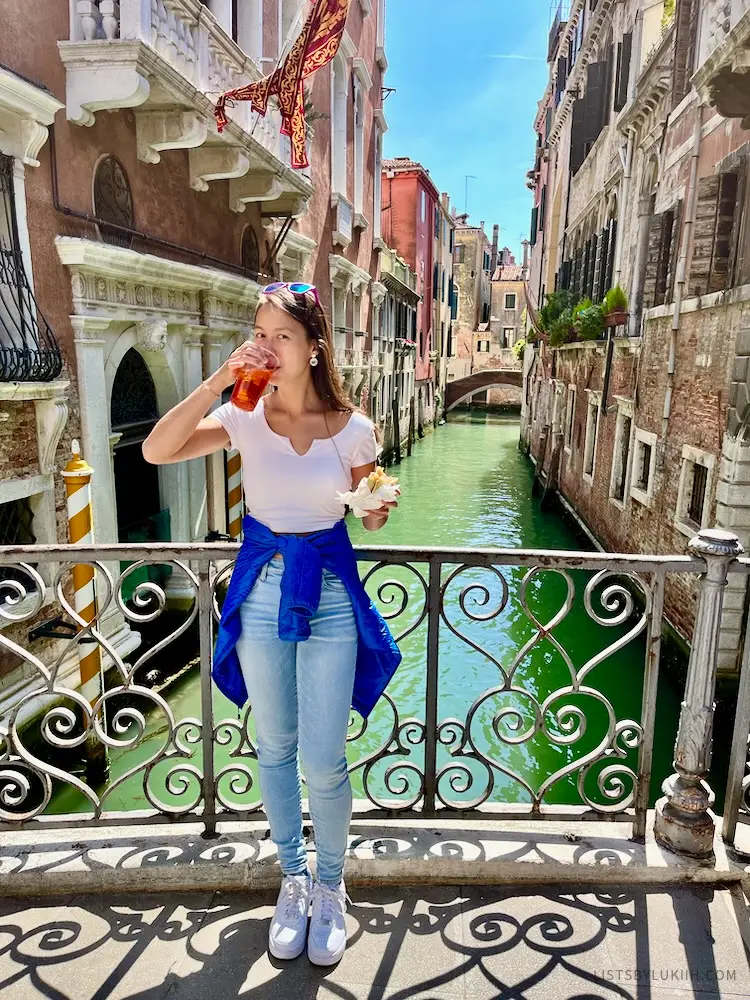
Getting Around Venice
Here’s how to get to Venice and get around once you’re there.
🚆 How To Get to Venice
The best way to get to Venice is by taking the train to the Santa Lucia train station in the Cannaregio district.
Alternatively, Venice also has a small airport, Venice Marco Polo Airport (VCE), that you can fly into. After landing, you’ll have to take a 30-minute bus ride to Venice.
👟 How To Get Around Venice
Getting around Venice is unique because the city has an intricate network of canals, bridges, and pedestrian-friendly streets. There are no cars in Venice.
Once in Venice, you can get around by walking, taking the water bus, or going on a water taxi.
- Walking – Because of the city’s compact size, one of the primary ways to get around Venice is on foot. This is how I primarily got around. Most major tourist attractions are concentrated in the San Marco district, and walking to the other districts is very doable.
- Water Bus – Due to Venice’s many canals, another popular way to get around is by water bus, also called a vaporetto. This is considered Venice’s primary public transport.
There are 19 lines of vaporetto, and different ticket types are valid for a certain period of time.
- Water Taxi – Unlike the water bus, water taxis are private and provide a more direct route to your destination. You can book a water taxi online at the Consorzio Motoscafi’s official website or by calling.
Gondola rides are extremely popular in Venice, but they’re primarily a tourist activity and not a means of transportation. A more affordable option is a traghetti, a large gondola that takes visitors across the Grand Canal.
Venice Itinerary Map
This map has all the recommended places in the Venice travel itinerary below.
1-Day Itinerary for Venice
Below is a great way to spend a whole day in Venice, featuring the best things to do in the city.
To help you plan efficiently, I’ve included suggested times for each activity based on my firsthand experience.
The Italy trip planner below has this itinerary prefilled.
| Morning in Venice | ||
| ⛪️ | Explore St. Mark’s Square and its top attractions | 9 am–12:30 pm |
| Afternoon in Venice | ||
| 🍝 | Eat a Venetian lunch | 12:45–2 pm |
| ⭐️ | Visit Rialto Bridge and its market | 2:15–2:45 pm |
| 🪴 | Explore the Castello district | 3–4:30 pm |
| 💧 | Walk to and cross the Ponte dell’Accademia | 4:30–5:15 pm |
| 👟 | Explore the Dorsoduro district | 5:15–6:30 pm |
| Evening in Venice | ||
| 🛶 | Go on an iconic gondola ride | 6:30–7 pm |
| ☀️ | Catch the sunset | 7:30–8:15 pm |
| 🥖 | Sip wine and eat cicchetti for dinner | 8:30–9:30 pm |
🗓️ With Less Time: What To Skip in Venice
If you have less time in Venice or want more downtime, here’s how to modify the itinerary:
- Skip walking to the garden in the Castello district
- Minimize your time in St. Mark’s Square unless you thoroughly enjoy learning about historic buildings
- Prioritize wandering the streets and enjoy the atmosphere of Venice more
Here’s a great, slower one-day Venice itinerary:
| Morning in Venice | ||
| 🚊 | Arrive in Venice (morning) | Morning |
| Afternoon in Venice | ||
| 🍝 | Eat a Venetian lunch | 12:30–2 pm |
| ⭐️ | Visit the Rialto Bridge | 2:15–2:30 pm |
| ⛪️ | Walk around St. Mark’s Square | 2:45–3:30 pm |
| 🪴 | Explore parts of the Castello district | 3:30–4:30 pm |
| 💧 | Walk to and cross Ponte dell’Accademia | 4:45–5 pm |
| 👟 | Explore the Dorsoduro district | 5:15–6:30 pm |
| Evening in Venice | ||
| 🛶 | Go on an iconic gondola ride | 6:30–7 pm |
| ☀️ | Catch the sunset | 7:30–8:15 pm |
| 🥖 | Sip wine and eat cicchetti for dinner | 8:30–9:30 pm |
🗓️ With More Time in Venice
If you have extra time or days in Venice, consider adding these things to the itinerary:
- Spend time in other parts of San Marco that are not in St. Mark’s Square – Other notable attractions in San Marco include Palazzo Contarini del Bovolo, a gem with a unique facade, and Teatro La Fenice, a renowned opera house that sits 1,000.
- Take a day trip to Murano Island – Murano is a small island that’s a 20-minute boat ride away from Venice. The island is known for its glassmaking heritage, offering glass factories, studios, museums, and shopping.
You can take a small-group Murano Island guided tour that provides transportation.
8 Great Things To Do in Venice
Having spent two packed days in Venice, I share my recommendations and honest opinions on the top attractions and activities below, listed in rough order of priority.
All prices mentioned here are in USD 💵 .
1. Visit St. Mark’s Square and Its Attractions
🤔 Why: St. Mark’s Square, or “Piazza San Marco,” is the central square of Venice surrounded by historic buildings. It’s a popular place for both tourists and locals.
⛪️ Main Attractions: St. Mark’s Square has six of Venice’s top sights:
- St. Mark’s Basilica (Basilica di San Marco) – Venice’s most iconic and significant landmark. The basilica showcases a blend of different architectural styles, serves as the city’s cathedral, and has survived fires, floods, and political upheavals.
The basilica is extremely popular and is almost always crowded, so expect long lines. It also has a dress code, so you need to cover your knees and shoulders to enter.
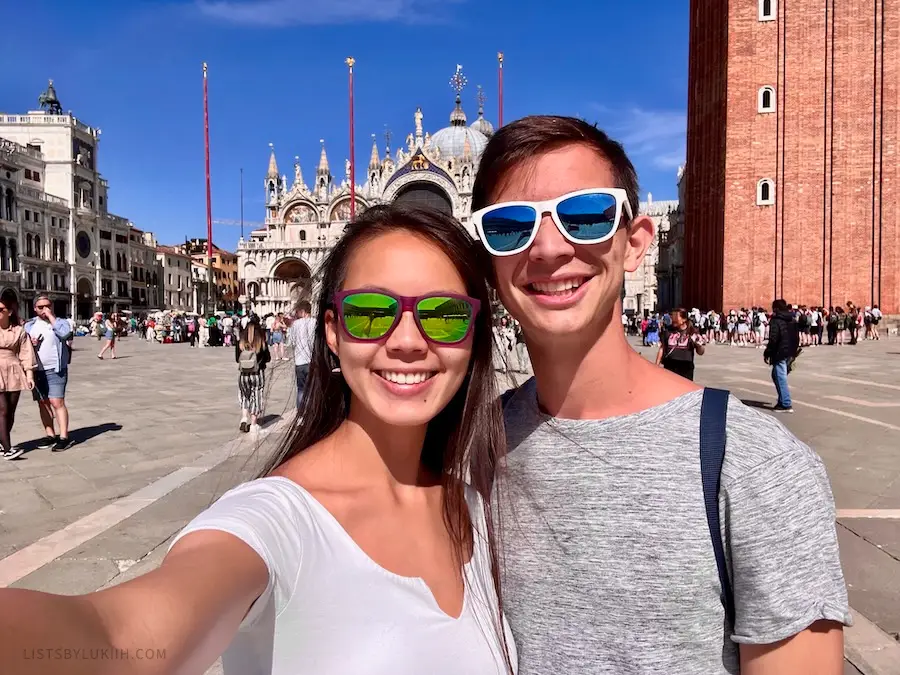
- Doge’s Palace (Palazzo Ducale) – another one of Venice’s most remarkable landmarks primarily due to its history.
Doge’s Palace’s significance is primarily based on history and culture. A guided tour of the palace and the basilica noticeably enhances the experience.
- Bridge of Sighs (Ponte dei Sospiri) – a famous bridge connected to Doge’s Palace. It’s named so because prisoners would sigh as they crossed the bridge, taking their last look at Venice. You can view this bridge from the nearby Ponte della Paglia.
- St. Mark’s Bell Tower (Campanile di San Marco) – built to spot fires from high above and is now the tallest structure in the square. Visitors can climb its spiral staircase to get the best view of Venice.
- Venice’s Clock Tower (Torre dell’Orologio) – another of the square’s iconic landmarks known for the intricate clock design on its facade.
- Correr Museum (Museo Correr) – the square’s museum and home to several Venetian art pieces.
💰 Expected Cost: All the attractions in St. Mark’s Square require entrance tickets costing between $10 and $35.
⏰ Suggested Duration: A guided tour of some St. Mark’s attractions will take two to three hours. Without a tour, budget 30 to 45 minutes to walk around the square and sightsee.
🍀 Lukiih’s Take: If you don’t plan to do any guided tours of the St. Mark’s attractions and stay in Venice for a night, I recommend visiting the square at nighttime. It’s a much more charming place at night with fewer crowds and potential live music.
2. Ride a Gondola Through the Canals
🤔 Why: Riding a gondola in Venice’s canals is one of the best and most iconic ways to see the beautiful city.
See the best places to catch a gondola ride in Venice.
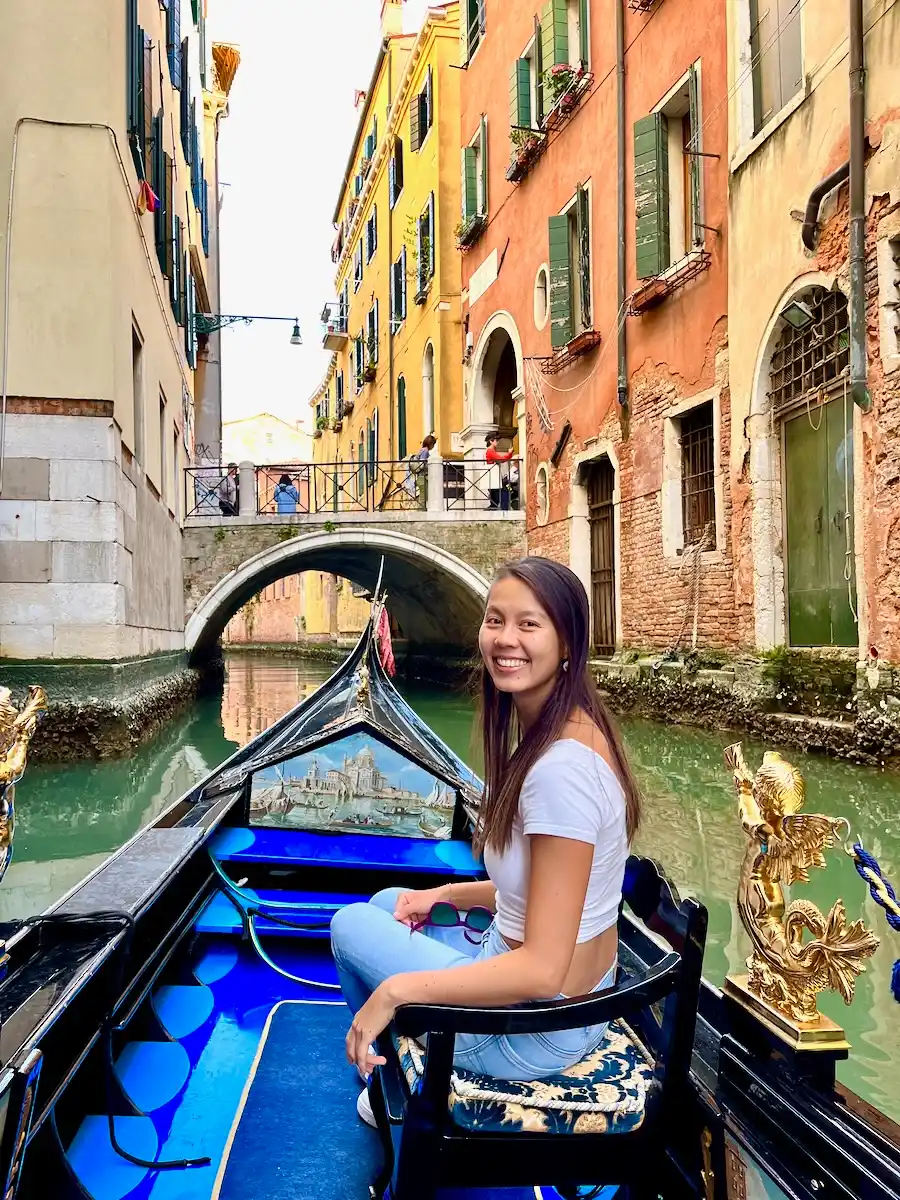
I highly recommend catching a ride in Dosoduro instead of one in San Marco because you’ll be able to experience the authentic, small canals.
💰 Expected Cost: A standard gondola ride is about $87, which is non-negotiable.
Gondola ride prices increase to $100 after 7 pm since sunset is a popular time to catch them, so riding one beforehand is a good idea.
⏰ Suggested Duration: A standard gondola ride lasts 30 minutes. You can pay extra for a longer ride.
🍀 Lukiih’s Take: I had not initially planned to ride a gondola in Venice due to the high price. However, it was a surprisingly delightful and unique experience. Exploring the small canals was tranquil.
See tips on catching a gondola ride in Venice.
3. Explore Dorsoduro District
🤔 Why: Dorsdoduro is a quieter, charming district worthy of exploration. It has scenic waterfront views and canals.
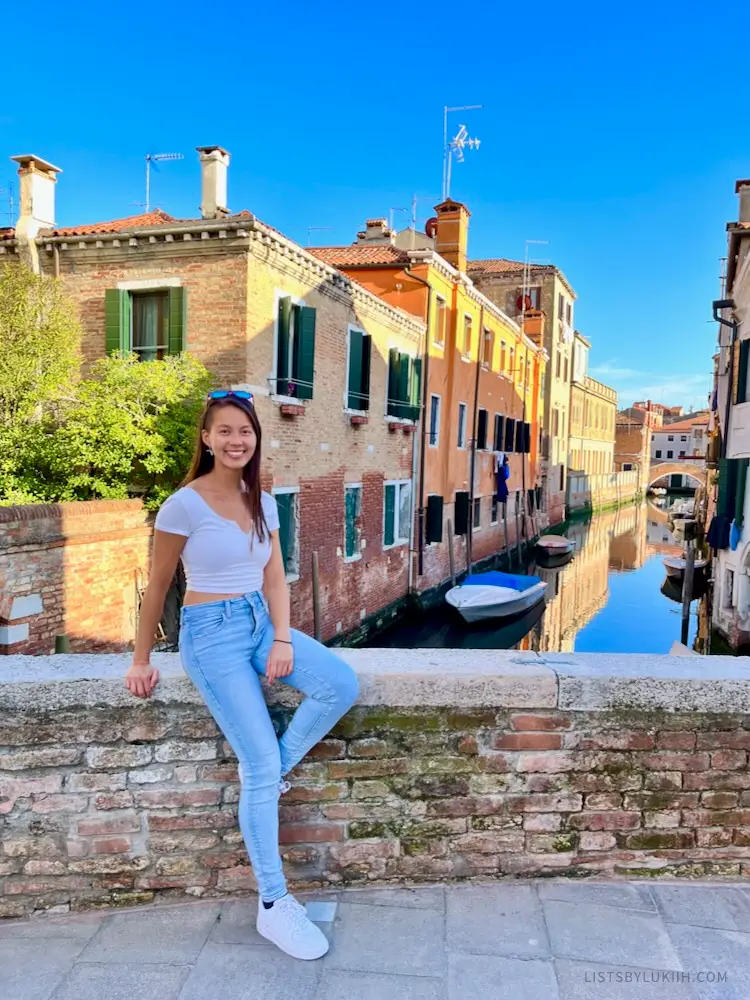
✨ Top Attractions: Dorsoduro has several attractions you can walk towards, but if you only have a day in Venice, you likely won’t have enough time to explore all of them.
- Punta della Dogana – the easternmost tip of the district, featuring a contemporary art museum.
- Peggy Guggenheim Collection – one of Venice’s most renowned modern art collections.
If you’d rather prioritize exploring Venice’s less well-known areas and attractions, consider booking a walking tour with a local guide.
⏰ Suggested Duration: 1 to 2 hours. I spent two hours walking there and enjoying the atmosphere.
🍀 Lukiih’s Take: Walking around the Dorsoduro district without a clear direction is one of my best memories of Venice. I enjoyed stumbling onto quiet, local streets with peaceful atmospheres.
4. Try Venetian Cuisine
🤔 Why: Italy is known for its culinary prowess. While Venice is touristy, it still boasts fantastic dishes and food that are hard to find elsewhere.
🥖 What To Eat: Here are some things to try in Venice:
- Cicchetti – a small snack often served by local wine bars. They’re bruschetta with all sorts of toppings and are one of my favorite things to eat in Venice. Osteria Al Squero and Vino Vero were my two favorite places among the ones I tried.

- Sarde in saor – a sweet-sour dish consisting of fried sardine fillets.
- Risotto al nero di seppia – a squid-ink risotto that looks like jet-black rice.
- Baccalà mantecato – an appetizer made with dried cod.
You’ll also see many locals and tourists enjoying a glass of Venetian spritz, a wine-based cocktail with a distinct red-orange hue. It has a sweet initial taste with a bitter finish.
If you want to prioritize food during your Venice trip, you can book this highly-rated street food tour.
💰 Expected Cost: Budget $2 to $4 per cichetti. A full meal for me was usually five to six pieces.
🍀 Lukiih’s Take:
Cicchetti was my favorite food in Venice. I loved selecting different cicchetti to try at wine bars while sitting by the canal.
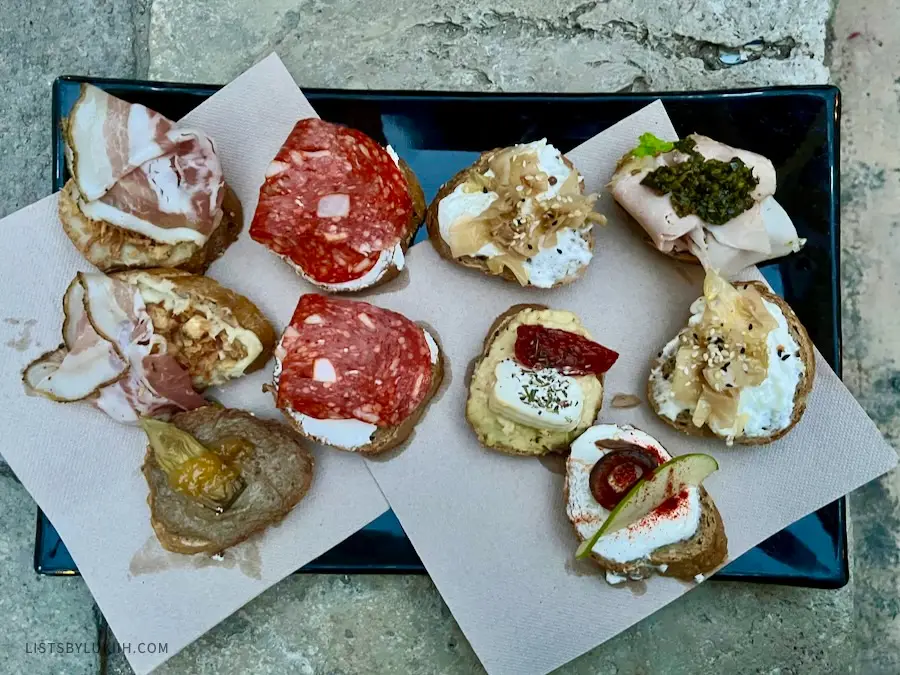
5. Cross the Rialto Bridge and Visit Its Market
🤔 Why: Rialto Bridge, or “Ponte di Rialto,” is Venice’s oldest bridge. It’s also the city’s most famous bridge because it offers the best view of the Grand Canal, Venice’s main waterway.
Two minutes from the bridge is the Rialto Market, which sells fresh produce daily except Sundays.
The Rialto Bridge is one of the most crowded areas in Venice, so don’t expect to have it for yourself except late at night and early in the morning.
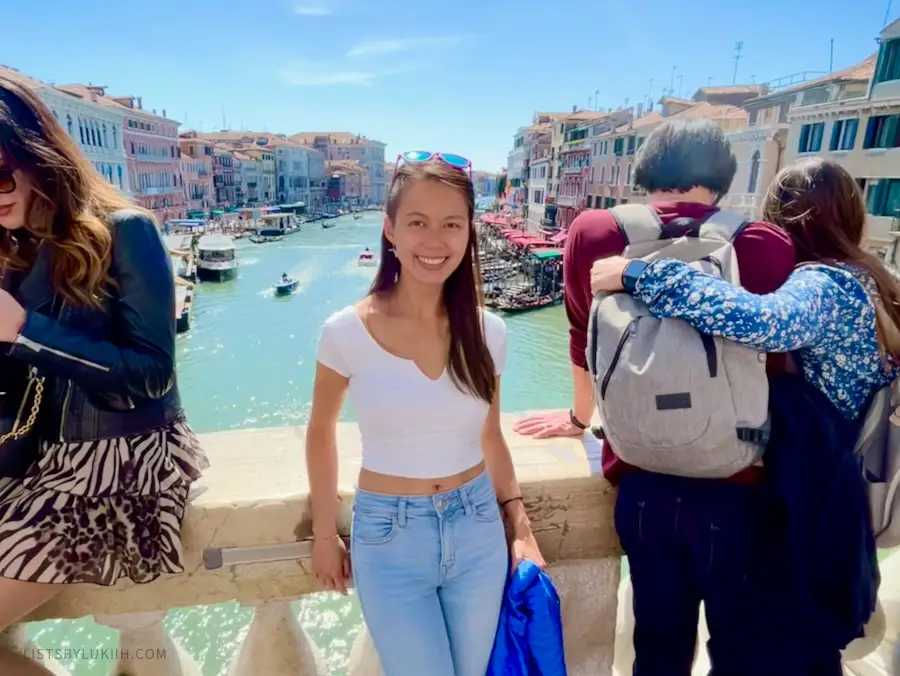
💰 Expected Cost: Both the bridge and market are free to visit.
⏰ Suggested Duration: Spend 10 to 15 minutes crossing and looking out of the Rialto Bridge. The Rialto Market can be visited briefly, or you can spend over an hour shopping there.
🍀 Lukiih’s Take: The Rialto Bridge provides a beautiful view of the Grand Canal, but I found it overly crowded throughout the day. I enjoyed visiting it later at night, which might not be feasible if you only have one day in Venice.
The bridge was not empty at 10 pm, but by then, you could at least take a photo of the canal without other people in the photo.
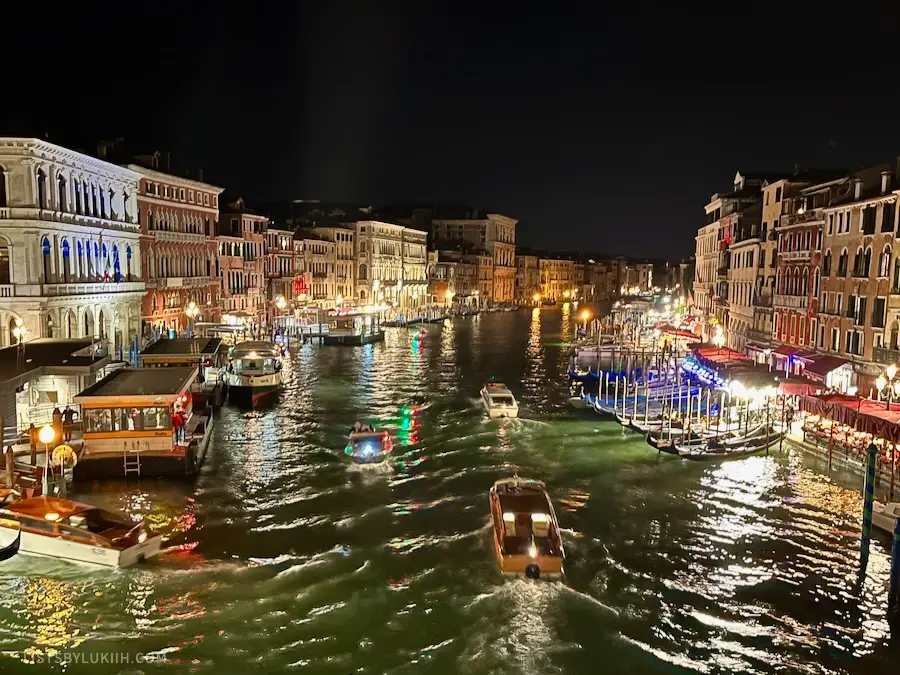
6. Explore Castello District
🤔 Why: Castello’s narrow streets have a distinct historic charm that you won’t get in the more famous San Marco district.
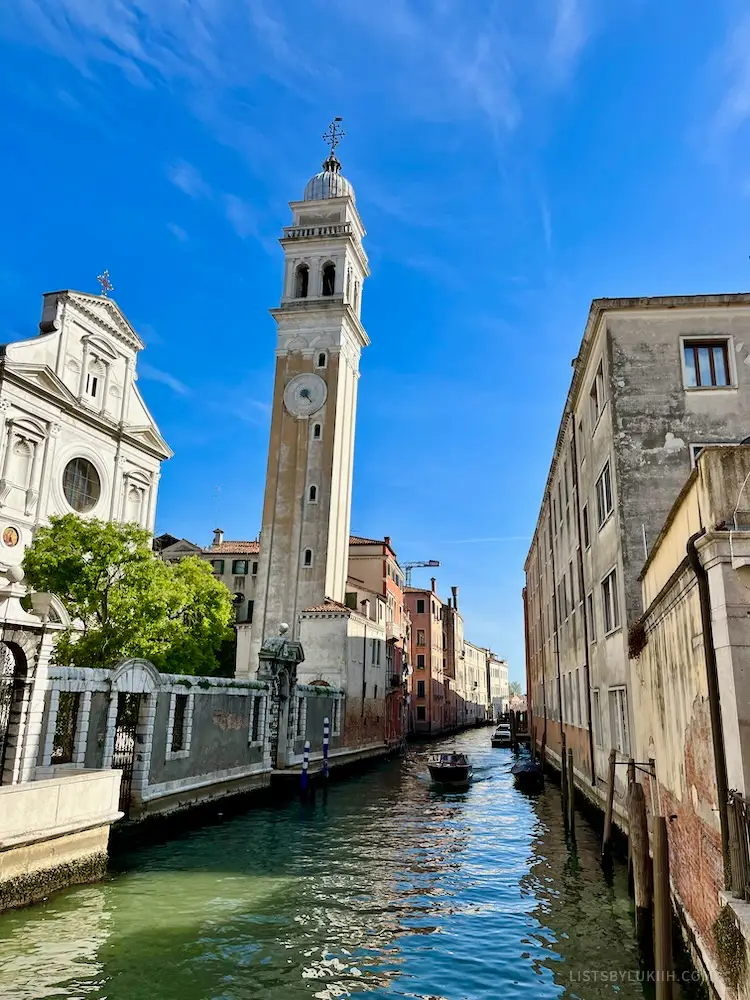
✨ Top Attraction: Castello has several notable attractions:
- Calle Varisco – the narrowest street in Venice at roughly 20 inches wide. It’s technically located in the Cannaregio district but only a ten-minute walk from Rialto Bridge.

- Libreria Acqua Alta – a unique bookstore that’s become famous because of the creative ways it displays its books. Books are stored in bathtubs and waterproof bins to protect them from the city’s frequent flooding.
- Giardini della Biennale – If you want to walk to the eastern end of Castello, you can head to the green area surrounding Giardini della Biennale, where there’s a lovely promenade.
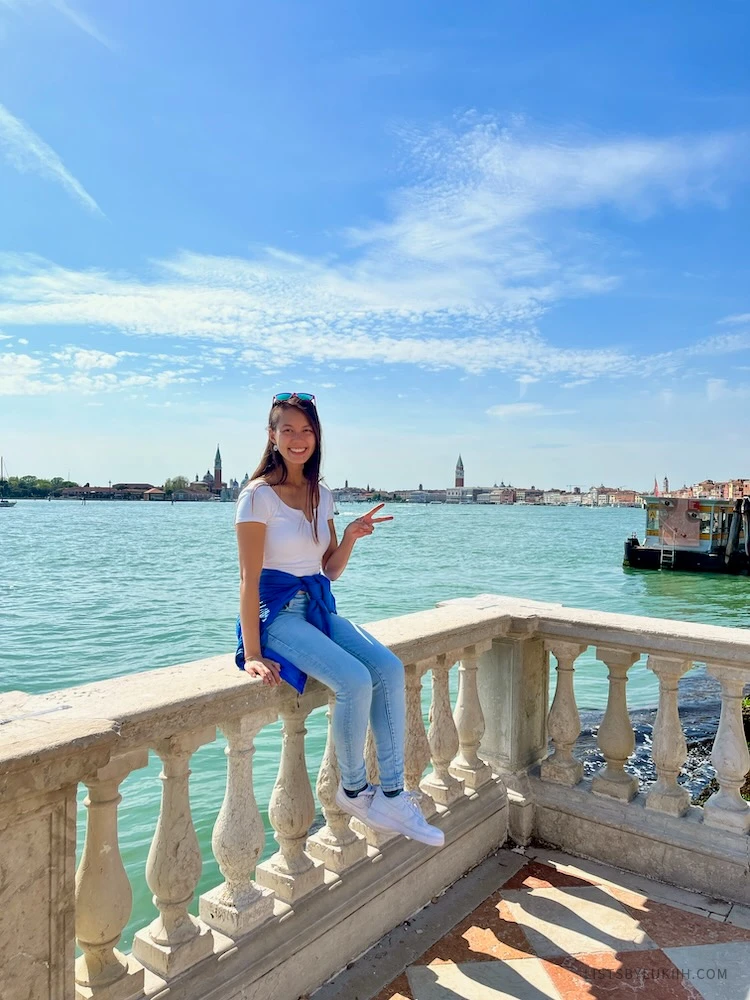
💰 Expected Cost: None of the attractions mentioned above have an entrance fee.
⏰ Suggested Duration: It takes approximately 30 minutes to walk from Calle Varisco to the garden area, so budget around an hour or more to make your way through Castello.
🍀 Lukiih’s Take: One of the best ways to explore Venice’s streets is to wander in a general direction without a clear destination. If you walk towards Giardini della Biennale, you’ll arrive at a green area with wide open spaces, which gives you a nice break from all the narrow streets.
7. Cross Ponte dell’Accademia
🤔 Why: Accademia Bridge, or “Ponte dell’Accademia,” is one of the four bridges in Venice that crosses the Grand Canal and is an important link to the Dosoduro district for locals.
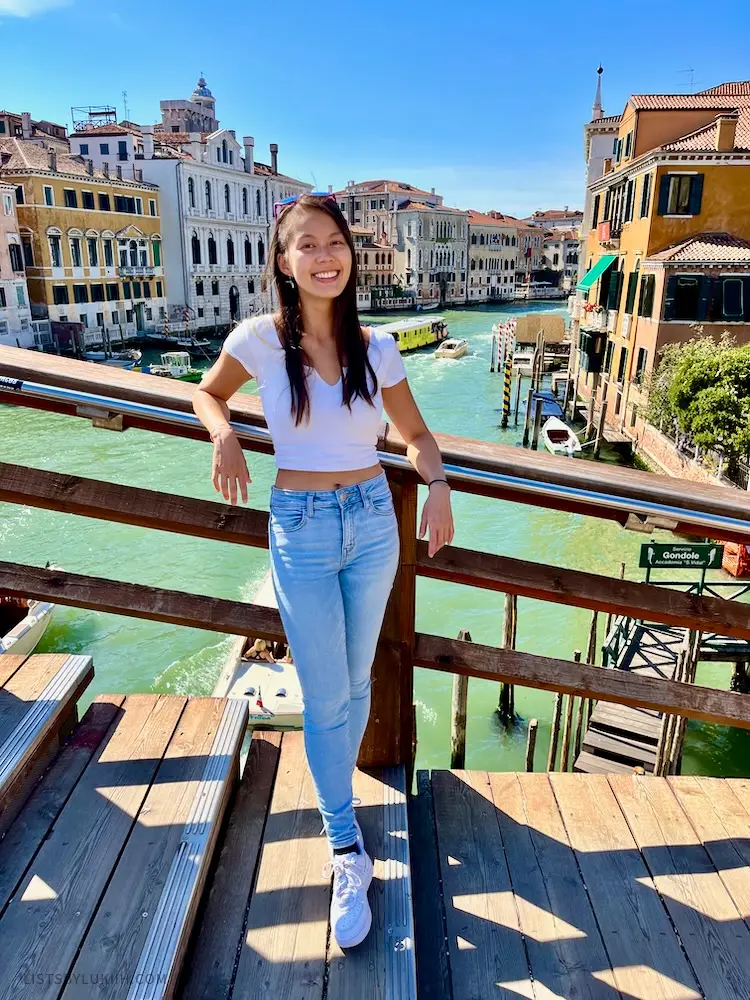
💰 Expected Cost: The bridge is free to visit.
⏰ Suggested Duration: 10 to 15 minutes
🍀 Lukiih’s Take: Ponte dell’Accademia is crowded, but not as crowded as the Rialto Bridge. It provides a more local view of the Grand Canal, so I think it’s worth a stop.
8. Catch the Sunset
🤔 Why: Venice is a picturesque city surrounded by water and short buildings, making it an ideal place to watch the sun sink. Here’s the sunset time for Venice.
☀️ Best Places: There are several great places to catch the sunset:
- Zattere Promenade runs along the Giudecca Canal, and it’s a great spot for locals and tourists to watch the sunset.
- Basilica di Santa Maria della Salute offers the opportunity to catch the sunset against the cathedral’s silhouette.
- Ponte dell’Accademia and Rialto Bridge are iconic places to see the sunset, but they will be very crowded.
💰 Expected Cost: None of these places have an entrance fee to watch the sunset.
🍀 Lukiih’s Take: I caught the sunset at the promenade, and it was a great spot because of how much space there was, whereas it would have been very crowded at the basilica or one of the bridges.
Where To Stay in Venice
Being a major tourist area, Venice accommodations are more expensive on average than those in other regions of Italy.
If you only have one night in Venice, consider staying in one of these districts:
- Cannaregio – Cannaregio is close to the train station, so staying here minimizes dragging your luggage around Venice’s cobblestone streets. This is the district where I stayed.
- San Marco or San Polo – Staying in San Marco or San Polo means you will be close to the major attractions. Most things you want to see will be within walking distance, but accommodations will be more expensive.
Italy Trip Planner 2024
To make your travel preparation easier, download the trip planner below. It has destination-specific travel information, itinerary, map, and packing list.
My trip planners are built on Notion, which I use for all my travel planning. I genuinely love this tool and creating an account is free.
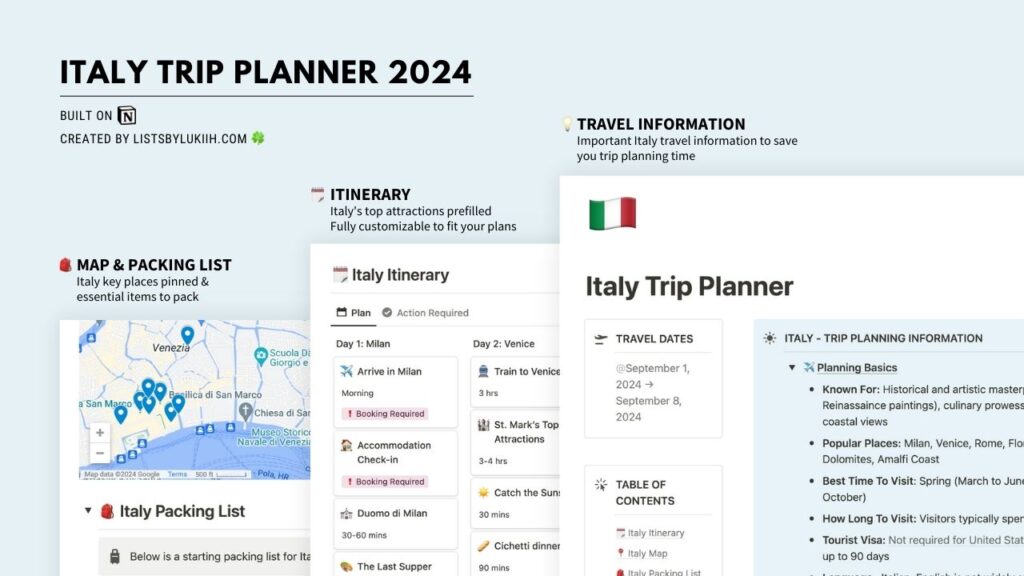
Italy Travel Guides
- 🇮🇹 Planning A Trip to Italy: 12 Practical Things To Know
- 🍝 7-10 Days in Northern Italy: 2 Efficient Itineraries
- 💰 My Italy Trip Cost: Budget Breakdown (2025)
- 🎭 Venice Day Trip: 8 Great Things To Do + 1-Day Itinerary
- 👨🎨 3 Amazing Days in Florence: Itinerary With Hidden Gems
- ⛰️ Hiking Cinque Terre: My Honest Review & Tips
- 🌷 Lake Como Day Trip: My Honest Review & Tips
- 🚣♂️ Gondola Ride in Venice: My Honest Review & Tips
- 🧀 Parma Day Trip (Italy): My Honest Review & Tips
